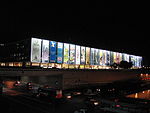SENAI
For the Malaysian town with the same name, see Senai.Serviço Nacional de Aprendizagem Industrial (SENAI), Portuguese language for National Service for Industrial Training is a network of profitable secondary level professional schools established and maintained by the Brazilian Confederation of Industry (a patronal syndicate). SENAI is one of the most important institutions in the country providing formal training for specialized workers for the industry, in the areas of chemistry, mechanics, construction, etc. SENAI has 744 operational units in all states of the Union, which offer more than 1,800 courses. SENAI is part of an integrated social action system which was founded by industry and political leaders in the 1950s, under the leadership of Euvaldo Lodi, which includes SESI (Social Service for Industry), and the Instituto Euvaldo Lodi.
Excerpt from the Wikipedia article SENAI (License: CC BY-SA 3.0, Authors).SENAI
SBN Quadra 1, Brasília
Geographical coordinates (GPS) Address Nearby Places Show on map
Geographical coordinates (GPS)
| Latitude | Longitude |
|---|---|
| N -15.791111111111 ° | E -47.878333333333 ° |
Address
Palácio da Agricultura
SBN Quadra 1
70002-900 Brasília
Federal District, Brazil
Open on Google Maps







